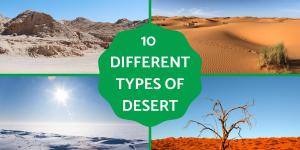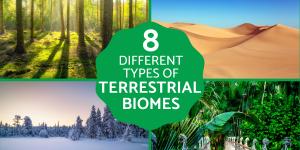Different Types of Aquatic Biomes


Our planet is a watery world, with aquatic biomes covering a vast majority of its surface. These biomes are classified based on factors like salinity (salt content) and water movement. Understanding aquatic ecosystems isn't just for curious minds. It's crucial for ensuring the health of our planet and all its inhabitants.
In the following article by thedailyECO, we explain the different types of aquatic biomes and their defining characteristics.
What is a biome?
Biomes are large geographical areas with similar climatic conditions and types of vegetation and animal life. These areas encompass various ecosystems within a specific region, sharing common environmental factors.
The word "biome" itself comes from the Greek "bios," meaning life, reflecting the interconnected web of organisms within each zone.
Broadly, biomes can be categorized as terrestrial (land-based) or aquatic (water-based). This article will focus on the fascinating world of aquatic biomes, exploring their distinct characteristics and types.
What is the main difference between a biome and an ecosystem?
A biome refers to a large geographical area with similar climatic conditions and types of vegetation, while an ecosystem is a localized system consisting of living organisms and their interactions with each other and their environment within a defined area.
Ever wonder how forests, grasslands, and deserts fit into the ecological picture? We unveil the secrets of terrestrial ecosystems in another article.
Characteristics of aquatic biomes
Aquatic biomes, encompassing 75% of our planet, are the largest biome on Earth. These vast underwater realms are characterized by several key features:
- Unlike terrestrial biomes where air is the primary medium, aquatic biomes are dominated by water. This aquatic environment shapes all aspects of life there, from how organisms obtain oxygen to how they move and reproduce.
- Aquatic biomes are also distinguished by salinity, with freshwater biomes like lakes and rivers having low salt concentrations, while marine biomes such as oceans and estuaries have higher salt concentrations.
- Sunlight is crucial for life as we know it. However, water has a strong ability to absorb light, especially certain wavelengths. This creates a layered effect in aquatic environments. The photic zone is the upper layer where sunlight penetrates and allows photosynthesis by plants and algae. The aphotic zone is the deep, dark zone where sunlight does not reach. Different organisms are adapted to thrive in these distinct zones.
- Water temperature varies depending on depth, location, and currents. Temperature plays a major role in the distribution of aquatic life. Some organisms are stenothermic, meaning they can only survive in a narrow temperature range. Others are eurythermic, able to tolerate a wider range of temperatures.
- Just like us, aquatic organisms need oxygen to breathe. The amount of dissolved oxygen (DO) in water is another key factor affecting the distribution of life. DO levels are generally higher near the surface where there is more gas exchange with the atmosphere. DO levels can be lower in deeper waters and areas with high decomposition rates.
- Aquatic biomes vary in nutrient levels, with some areas rich in nutrients while others are nutrient-poor. Nutrient availability influences the abundance and diversity of aquatic life, particularly plant growth and primary productivity.
- The acidity or alkalinity of water, measured by pH levels, plays a crucial role in aquatic ecosystems. Different organisms have varying tolerances to pH levels, and extreme changes can disrupt aquatic life.
Curious about the life that thrives beyond the salty seas? Explore the freshwater ecosystems that lie closer to home in our article on inland waters.

Types of aquatic biomes
Aquatic biomes can be broadly divided in two major types of aquatic biomes based on salinity:
Freshwater biomes
These biomes are characterized by having low salinity, or a low concentration of dissolved salts. Freshwater ecosystems are vital for the health of our planet, providing drinking water, habitat for a variety of organisms, and playing a crucial role in the water cycle. Here are some of the major types of freshwater biomes:
- Lakes and ponds
- Rivers and streams
- Wetlands
Marine biomes
These biomes are characterized by having high salinity, or a high concentration of dissolved salts. Marine ecosystems cover a vast expanse of our planet and are home to an incredible diversity of life, from microscopic plankton to giant whales. Here are some of the major types of marine biomes:
- Estuaries
- Coral reefs
- Kelp forests
- Seagrass meadows
- Deep sea
Delved into the various aquatic biomes, but curious about the bigger picture? Dive deeper into what defines an aquatic ecosystem in our follow-up article.
Freshwater biomes
While marine biomes dominate the planet's surface, freshwater biomes, encompassing a diverse range of aquatic habitats, play a vital role in the health of our planet. These life-giving ecosystems provide us with drinking water, regulate regional climates, and nurture a unique tapestry of freshwater plants and animals.
Lake
A lake is a naturally formed body of water on the Earth's surface, typically large and relatively stable in size. It occupies a basin or interconnected basins surrounded by dry land, entirely separate from the ocean. However, like the vast oceans, lakes play a crucial role in the Earth's water cycle by serving as significant reservoirs of stored water.
While the majority of lakes contain freshwater and constitute nearly all of the world's surface freshwater, some are saline, with salt concentrations even surpassing that of seawater. Lakes exhibit considerable diversity in terms of surface area and volume.
Pond
A pond is a small body of water formed on land, usually in depressions, either naturally or artificially. They are shallower and smaller in size compared to lakes, often less than 5 hectares in area and 5 meters in depth. Ponds can vary in water level, nutrient content, and light availability, influencing the diversity of aquatic life they support, which includes algae, fish, frogs, turtles, and various insects. They play important roles in ecosystems, providing habitats for wildlife and serving as breeding grounds for amphibians.
River and creeks
A river is a natural watercourse, typically a freshwater stream, that flows across the Earth's land surface or through caves toward a lower elevation, ultimately reaching another body of water such as an ocean, sea, bay, lake, wetland, or another river.
Some rivers may terminate by flowing into the ground or drying up before reaching another waterbody. Smaller rivers may be known by various names like creek, brook, or rivulet, with no official definitions distinguishing these terms. While a river is often considered larger than a creek, distinctions between these terms can vary and may lack precision.
Wetlands
A wetland is a unique ecosystem characterized by being flooded or saturated with water, either permanently for extended periods or seasonally for shorter durations.
This inundation leads to oxygen-free (anoxic) conditions, particularly in the soils. What sets wetlands apart from terrestrial land forms or bodies of water is the presence of specific aquatic plant species adapted to these anoxic, waterlogged soils.
Wetlands are naturally occurring features found on every continent, and the water within them can be freshwater, brackish, or saltwater. Different wetland types are classified based on the dominant plant species and/or the source of the water.
- Marshes: dominated by emergent vegetation like reeds and cattails, providing critical spawning and nursery grounds for fish and amphibians.
- Bogs: spongy, acidic wetlands with characteristic moss and stunted trees, often receiving water primarily from precipitation.
- Swamps: forested wetlands dominated by trees such as cypress or mangroves, providing habitat for a variety of birds, mammals, and aquatic life.
Not quite ocean, not quite lake. Uncover the fascinating world of brackish water, a special blend of freshwater and saltwater, in our follow-up article.

Marine biomes
The surprising and extensive aquatic biomes of ocean waters are distributed within the limits of the 5 great oceans of the planet (Atlantic, Pacific, Indian, Antarctic and Arctic). In them, we can differentiate the following biomes:
Estuaries
An estuary is a partially enclosed coastal body of water with brackish water, receiving one or more rivers or streams and having a direct connection to the open sea. Estuaries serve as transitional zones between river and marine environments and represent ecotones. They experience both marine influences, including tides, waves, and the entry of saline water, and fluvial influences such as freshwater flows and sediment deposition.
The blending of seawater and freshwater results in elevated nutrient levels, making estuaries highly productive natural habitats.
Coral reefs
A reef is a geological formation resembling an underwater mountain, composed of rock, coral, or other durable materials, situated beneath the water's surface. Natural reefs are often created through processes like the accumulation of sand or the gradual erosion of rock outcrops by waves. However, the most iconic reefs, such as tropical coral reefs, are formed by living organisms like corals and coralline algae.
Additionally, artificial reefs, deliberately established through intentional actions or accidentally by events like shipwrecks, serve to enhance marine habitats by providing structure and shelter for diverse organisms. While reefs typically lie close to the water's surface, not all definitions necessitate this proximity.
Kelp forests
Kelp forests are underwater ecosystems characterized by dense concentrations of kelp, spanning significant portions of the world's coastlines. These areas, also referred to as kelp beds on a smaller scale, are renowned as some of the most productive and dynamic ecosystems on the planet. Despite covering only 0.1% of the Earth's total surface, combined kelp forests and coral reefs contribute significantly to global primary productivity, accounting for 0.9%.
Physically formed by brown macroalgae, kelp forests offer a unique habitat for a diverse array of marine organisms.
Seagrass meadows
A seagrass meadow, also known as a seagrass bed, constitutes an underwater ecosystem predominantly formed by seagrasses. These marine plants thrive in shallow coastal waters and the brackish environments of estuaries, characterized by their long, green, grass-like leaves and flowering structures. Seagrasses form dense underwater meadows, ranking among the most productive ecosystems globally.
They serve as critical habitats and food sources for a diverse array of marine life, comparable to the biodiversity found in coral reefs. Moreover, seagrass meadows offer coastal storm protection by absorbing wave energy with their leaves, thereby mitigating coastal erosion.
Deep sea
The deep sea refers to ocean depths where light begins to diminish, typically around 200 meters (660 feet), or at the point where continental shelves transition to continental slopes. This environment is characterized by low temperatures, darkness, and high pressure, making it one of the least explored Earth biomes due to its extreme conditions.
Organisms inhabiting the deep sea exhibit various adaptations to thrive in this environment. They employ diverse feeding methods, including scavenging, predation, and filtration, with some relying on marine snow for sustenance. Marine snow consists of organic material that descends from upper waters into the deep sea, serving as a crucial food source for deep-sea organisms.
Curious about the chemistry behind the aquatic world? Unveil the fascinating properties of ocean waters in our follow-up article.

If you want to read similar articles to Different Types of Aquatic Biomes, we recommend you visit our Ecosystems category.
- Sánchez-Cañete, FJ and Ponte, A. (2010) Understanding ecology concepts and their implications for environmental education. Eureka Magazine on Science Teaching and Dissemination. Volume 7.
- Valdez, E. (2016) Biogeography. Autonomous University of the State of Mexico , pp: 5-16.
- Alexandre, F. & Durand-Dastes, F. (10/25/2008) Biome. Hipergéo Magazine.








